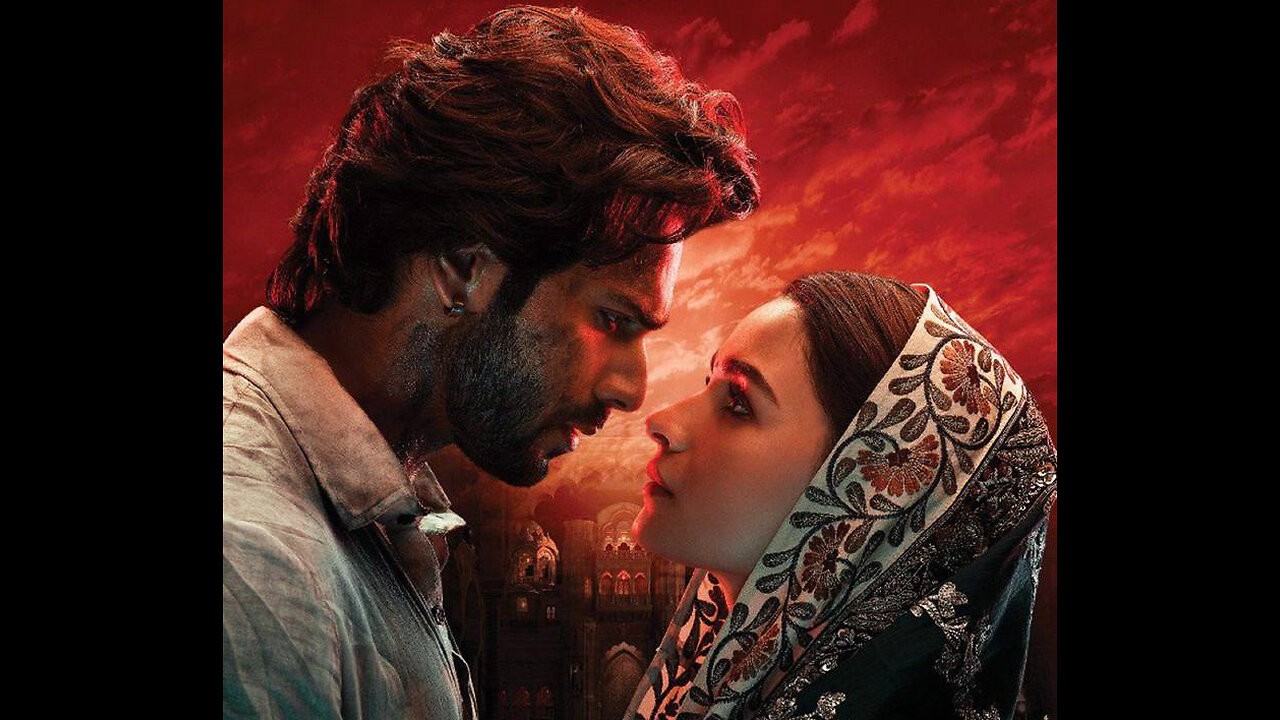Premium Only Content

HOLY SPIRIT OF INDIA ! = ACT 1 - SCENE 12 = KALANK ! PASSIONATE LOVE DURING BLOODY RIOTS BETWEEN MUSLIMS, SIKHS & HINDUS
This new composition of mine is based on the beautiful and deeply moving 2019 Indian Hindi-language romantic drama film ‹ Kalank ›, whose epic action and passionate love affairs occur in the midst of violent and bloody riots against Hindus and Sikhs.
The original film’s plot involves three main characters within a powerful love triangle.
At first we meet Satya Chaudhry, a young woman who is told by her doctor that she has cancer and will die soon.
So she goes back to her native village in the Rajputana area, and requests her childhood acquaintance, a lovely young woman named Roop, to provide companionship to her husband, Dev Chaudhry, who runs a liberal newspaper.
Roop keeps rejecting Satya's proposal, but later gets convinced by her father, Dharampal, to do so, and therefore agrees, but on the condition that she will marry Dev, to which Satya agrees.
Once married, Dev tells Roop that he still loves Satya, and that their relationship will only be cordial and platonic.
A depressed Roop takes solace in music, which she begins by learning from the madam of a brothel, Bahaar Begum.
She also begins working in her husband's publishing house, to use her education to their advantage.
Roop expresses interest in writing about the condition of the locality in which the brothel is located, during which time she meets with a handsome, womanizing blacksmith, named Zafar.
The handsome Zafar wants to exact revenge on his parents, Bahaar Begum and Balraj Chaudhry - who abandoned Zafar after ending his extramarital affair with Bahaar - by seducing lovely Roop, since she is married to Balraj's legitimate son, Dev.
But Roop misconstrues Zafar's intentions, and actually falls in love with him.
Roop also begins to develop a friendship with Dev, much to Satya's happiness as well as sadness.
Before dying, Satya urges Dev to give Roop a chance, and to forgive Balraj for his affair.
As part of another effort to humiliate Balraj, Zafar instigates communal hatred in his friend, Abdul Khan, by demanding for the partition of India on religious grounds, which Balraj and Dev do not support.
When Balraj becomes aware of Roop and Zafar's love, he confronts Bahaar and Zafar.
Bahaar, who disagrees with Zafar's approach, warns Roop and tells her about Zafar's real intentions.
Heartbroken, Roop consummates her marriage with Dev, but insists that she will never be able to fully love him.
As Abdul's political stance gains leverage, riots against Hindus and Sikhs in the city take place, during which the Chaudhrys decide to flee to Amritsar with the help of Zafar. But not before Saroj, the benevolent maid, is brutally stabbed to death.
Zafar confesses to Roop that he eventually fell in love with her, despite his early manipulative intentions.
While boarding a train to flee the violence in town, Zafar is stabbed in his stomach four times with a dagger by Abdul, while Roop and Dev manage to escape.
The story ends ten years later, when Roop and Dev are interviewed about their experience by Aditya, a journalist documenting the partition; with Roop remembering Zafar, and Roop's inner voice saying that the color of both love and hate is red. But that it is love that, alas all too often gets wounded.
FAIR USE - Section 107 of the Copyright Act 1976
This is a non-profit video that I personally composed solely for the purpose of study, review, research, self-expression, experimental analysis, creative research, humorous contrasting, cultural and educational philosophy, and basically for the love of artistic creativity itself, without any intention for any commercial uses whatsoever, and fully and absolutely for non-profit public display.
This video is for educational purposes only; and is offered freely to the public.
In composing this audio-visual film video, I am respecting the Copyright Disclaimer Under Section 107 of the Copyright Act 1976, whereby allowance is made for fair use, for purposes such as criticism, comment, news reporting, teaching, scholarship and research.
Fair use is a use permitted by copyright statute that might otherwise be infringing.
Non-profit, educational, or personal use, thankfully tips the balance in favor of fair use, thus promoting both the original work and other possible creative derivatives.
I made use of images in this composition that do belong to other film and music production firms. However, such a composition is unique and original in its full assembly, and is for educational and non-profit purposes only.
The original film production images and original music melodies in this film remain the property and copyright of its rightful owner, or owners.
I claim no ownership whatsoever on any of the materials I have used in creating this new audio-visual composition, except those that are my own to improve the state-of-the-art, and that I offer freely to the public worldwide.
Sincerely,
Teri'irere Ito'arai
Film Composer
The Holy Spirit of India !
-
 12:46
12:46
RealReaper
1 day ago $5.04 earnedMufasa is a Soulless Cash Grab
52.3K5 -
 5:14:24
5:14:24
FusedAegisTV
12 hours agoWelcome to The King of Iron Fist Tournament! \\ TEKKEN 8 Stream #1
88.8K1 -
 DVR
DVR
Bannons War Room
1 year agoWarRoom Live
101M -
 5:42:36
5:42:36
FreshandFit
18 hours agoLive X Censorship For Opposing Immigration?!
197K103 -
 1:08:16
1:08:16
Tactical Advisor
13 hours agoNEW Budget Glocks | Vault Room Live Stream 011
95.9K8 -
 16:30
16:30
SNEAKO
20 hours agoNO FRIENDS IN THE INDUSTRY.
135K64 -
 6:19
6:19
BlackDiamondGunsandGear
1 day agoHow Fat Guys can Appendix Carry
95.3K12 -
 6:58
6:58
Gun Owners Of America
1 day ago2024 Was Huge For Gun Rights, Here's Our Top 10 Wins!
76.9K8 -
 15:50
15:50
Degenerate Jay
1 day ago $2.82 earnedJames Bond Is Being Ruined By Amazon? Make Him A Black Gay Woman?
58K11 -
 15:18
15:18
DeVory Darkins
1 day ago $23.77 earnedTrump Drops NIGHTMARE Warning on Joe Biden
73.1K109